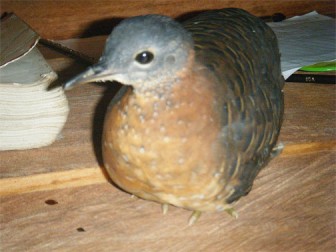The Variegated Tinamou (Crypturellus variegates) species was first identified from a specimen collected in French Guiana and is the larger cousin to the Little Tinamou. In general, the Varigated Tinamou ranges from southern and eastern Colombia, southern Venezuela, French Guiana, Guyana, Suriname, Amazonian Brazil, eastern Peru, eastern Ecuador and northern Bolivia.
The Variegated Tinamou is solitary and favours humid lowland forest with thick undergrowth; it prefers to be on the ground and flies when disturbed. Tinamous are earth coloured and are perfectly camouflaged with their environment. ![]() The upper back is rufous, the lower back and wings black with conspicuous yellowish bands. The throat is white while the neck and upper breast are rufous with a buff lower breast and belly; the flanks are tinged cinnamon and lightly barred dusky. The crown and sides of head are black with a yellowish bill and greenish brown legs.
The upper back is rufous, the lower back and wings black with conspicuous yellowish bands. The throat is white while the neck and upper breast are rufous with a buff lower breast and belly; the flanks are tinged cinnamon and lightly barred dusky. The crown and sides of head are black with a yellowish bill and greenish brown legs.
 The Variegated Tinamou does not have a song but emits a series of pure calls that can descend into a trill or what is called a wailing whistle; some people say that Tinamous are local clocks or time tellers as they call on the hour, every hour.
The Variegated Tinamou does not have a song but emits a series of pure calls that can descend into a trill or what is called a wailing whistle; some people say that Tinamous are local clocks or time tellers as they call on the hour, every hour.
The Variegated Tinamou feeds on fruit and some insects. The males are usually responsible for incubating the nest of eggs that may come from as many as 4 females. The females may form small associated groups working to lay a clutch for the male or they may lay for the male without forming any associations. After hatching the males will stay with the chicks until they can fend for themselves. This may be 2-3 weeks. The nests are created on the ground in dense brush or between the raised roots of trees.
Like its other family members the Variegated Tinamou is hunted for food. The species is believed common within its range and is listed as Least Concern by IUCN even though trends are showing declines in the population.
Rain forests are rich in biodiversity and are home to many different plants and animals. In addition, indigenous communities make their homes there. Even if you don’t live in the rain forest, humans rely on the forest for resources such as building materials (wood and lianas), medicine and fruits. Rain forests also provide essential environmental services for life on earth; they create soil as well as prevent soil erosion, produce oxygen though photosynthesis, maintain clean water systems, and are a key defence against climate change.
The Iwokrama Rain Forest is 371,000 hectares, located in the heart of Guyana. Our mission is to develop strategies for conservation and sustainable development for local people in Guyana and the world at large. We are involved in tourism, training, research and our timber is certified by the Forest Stewardship Council. Come and visit us in the rain forest or at http://www.iwokrama.org.










